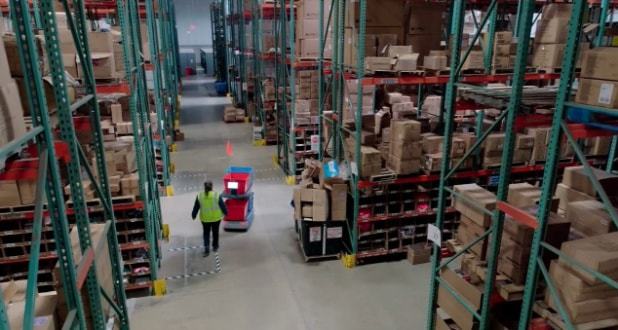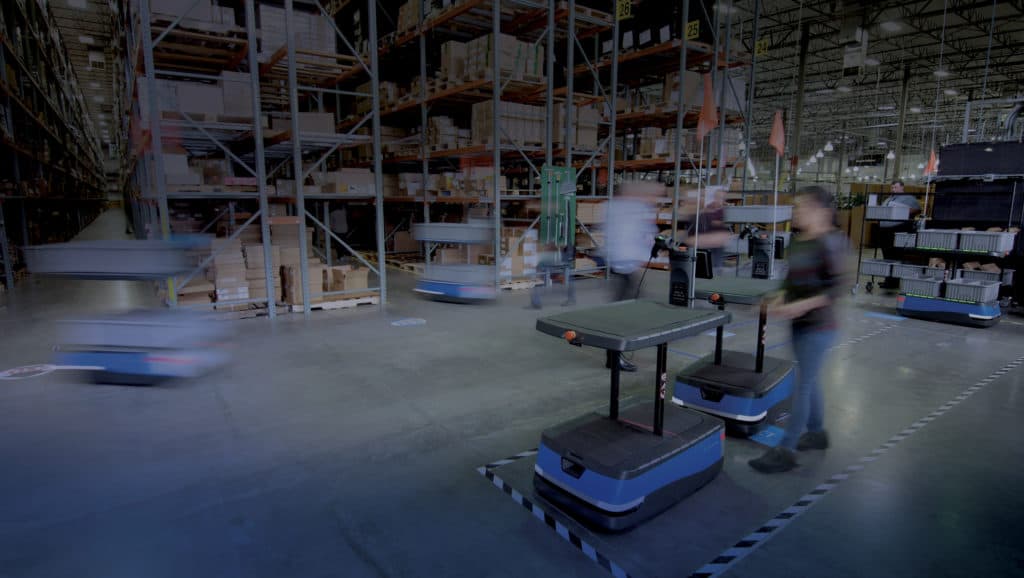For today’s consumers, two-day shipping (or faster) for online purchases was the new normal before the COVID-19 pandemic. While supply chain interruptions have made two-day shipping challenging, if not impossible, in recent months, the demand for rapid delivery hasn’t gone away. As the world returns to a new normal and supply chains begin to recover, companies will continue to strive to meet the demand for two-day and even same-day delivery by investing in order fulfillment technologies to improve your fulfillment operations.
Luckily for many operations — both large and small — building a speedy and accurate order fulfillment system is more achievable when three things are adopted: 1) collaborative technologies, 2) strong organizational techniques and 3) common sense.
To speed up fulfillment and accuracy, you must take a comprehensive approach and look at the warehouse as a whole with the aim of building an effective order fulfillment process that raises customer satisfaction levels, reduces costs and improves profit margins.
What are the benefits of an effective warehouse order fulfillment process?
Optimizing order fulfillment operations is a must for companies looking to offer consumers the same/next-day delivery. By revving up order cycle times, e-commerce stores and retailers can engender faster fulfillment times to satisfy consumers’ demand for faster deliveries.
Also, an effective order fulfillment process is a must-have for companies looking to thrive in the face of ever-changing consumer preferences and the evolving business landscape, including the unprecedented challenges presented by the COVID-19 pandemic. While significant investment in time and resources is often needed to facilitate this, there are significant benefits as well.
For one, speeding up order fulfillment allows you to offer consumers later order cut-off times. This has a positive impact on sales and expands your potential customer base.
Also, effective order fulfillment usually comes with faster replenishment cycles. As such, fulfillment centers no longer need to keep high levels of inventory as safety stock.
Some companies expedite a large portion of shipments to meet delivery promises. Processing orders faster allows companies to reduce the need for expedited shipping and cut transportation costs by using less expensive shipping options. Speedy fulfillment also gives you the latitude to negotiate more favorable terms with carriers.
How do you improve your warehouse order fulfillment process?
An effective order fulfillment process simply means getting the right product to consumers quickly, efficiently and at the lowest possible cost.
As such, optimizing order fulfillment operations requires a trade-off between three components: order receipt, order processing and shipping. Streamlining the processes for each of these components will result in an optimized order fulfillment workflow. With this in mind, let’s explore several key things you can do to improve your order fulfillment process.
Inventory
First, ensure that you have the right type and amount of inventory at the right location. This requires accurate sales forecasting and a streamlined order replenishment process. Leveraging the right kind of technology simplifies both processes.
It enables you to identify slow-moving products to keep them from occupying too much space while keeping large quantities of fast-moving products in optimal locations. With this approach, all your products keep turning over, thus maximizing warehouse space, driving efficiency, and reducing operational cost.
Lastly, customers should have complete real-time visibility into available inventory. Having the right product means little if your customers think it’s out of stock. Essentially, focus on keeping the right products in stock while providing customers with visibility into inventory.
Streamlining picking, packing and packaging
With accurate inventory data, companies can improve order picking accuracy and speed. Of course, this involves choosing a picking method that’s best for the type of orders received, warehouse layout and technologies in use. Position fast-moving inventory in hot zones to minimize travel time around the warehouse.
Consumers now have a ton of expectations surrounding what, when and how their orders are delivered. While companies pat themselves on the back when they consistently and speedily deliver complete orders at the right address, consumers expect much more.
The appearance and cartonization of the product plays a huge role in influencing customers’ perceptions of service delivery. This perception can make or break the entire purchase experience and by extension, the customer experience. With this in mind, businesses need to use correctly-sized, eco-friendly boxing to package orders. A lot of e-commerce and omnichannel retailers already use void fill material and branded boxes/bags.
Improve last-mile delivery
Consumers have come to expect products within 24 – 48 hours after placing their orders. As such, companies that can cost-effectively deliver products to consumers the fastest will retain/gain market share. Although meeting the demand for same-day or next-day delivery is a significant challenge in the midst of the COVID-19 pandemic, consumers continue to turn to retailers that offer fast delivery options. As supply chains recover from significant disruption, retailers will strive to return to meeting their pre-pandemic delivery services, as well. For instance, in mid-May 2020, Amazon stated that it anticipated a gradual return to the previous one-day and two-day delivery times customers had come to expect within a few weeks’ time. As many items were out of stock and delivery times were extended, by weeks in some cases, consumers turned to curbside pickup options offered by other big-box retailers like Target and Walmart to get their products faster, making it critical for Amazon to resume its normal delivery times as quickly as possible to retain its customer base.
Last-mile delivery is a critical part of the order fulfillment process. Improving this will require strategic logistics planning and collaboration with carriers and 3PL service providers and other avenues of alternative transportation.
While everyone loves faster fulfillment time, it does come with certain costs and tradeoffs. For one, a lot of companies see reduced margins or lose money outright on certain orders when they speed up order fulfillment activities. To keep a handle on costs, supply chain managers should take a long-term view and strategize on how to keep operational expenses to a minimum while improving the order fulfillment process.
This involves the following:
- Leveraging collaborative robots to enhance picking speed and accuracy
- Integrating systems and automating as many manual processes as you can
- Reorganizing networks, allocation of inventory along nodes and the placement of physical buildings to reduce transportation costs and time to customers
- Redesign the distribution center to facilitate the preferred order processing window
- Deploying the right technology where necessary
- Parallelizing order fulfillment processes
- Optimize shipping by trying out new carriers and order fulfillment strategies while measuring cost and service impact
To help you achieve an efficient order fulfillment process, we’ve rounded up expert tips and strategies to help you get started, including supply chain strategies, order picking strategies, warehouse automation tips and more. Within these categories, you’ll find sage advice from some leading warehouse pros and order fulfillment experts.
Use the menu below to jump to a section of interest:
- Supply chain and visibility strategies
- Warehouse layout strategies
- Order picking strategies
- Warehouse management system tips
- Warehouse automation tips
Supply chain and visibility strategies

1. Use cloud-based technology to strengthen end-to-end visibility. “Organizations can consider deploying cloud technology that helps capture, report and leverage important benchmarking data and provides insight into supply chain performance. These cloud solutions must have analytics platforms that allow you to assess partners, be informed on risk management and analyze the system’s effects on profit margins. As more and more technology moves into the cloud, organizations can reap the benefits of anytime, anyplace, anywhere access to data. An added benefit of cloud technology is that it enables organizations to reduce upfront costs and save on onsite maintenance down the line.” — Larry Lewis, Reaching End-to-End Supply Chain Visibility, Supply Chain 24/7; Twitter: @SupplyChain247
2. Create simple and sleek customer forms. “Your customers are the ones who place the orders; so in order to get more orders, it is important to make the order fulfillment process easier, faster and more accessible. The forms must be easily available (whether online or printed), short and easy to understand and requiring minimum information to be entered. Customers usually do not bother with difficult-to-find, hard to understand and lengthy order forms, preferring to go to another supplier/vendor instead.” — Marco, Grossi, Tips for Improving the Order Fulfillment Process, 3PL Links; Twitter: @3pl2Save

3. Check in often with your workers as well as supply chain partners. “Ask workers about frustrating elements in their daily routine. What tools or resources could they use to improve their job, for example? This is one way to highlight gaps in communication. Often someone needs something but hasn’t asked for it, someone else doesn’t know they should be providing it, or sometimes both! Simply asking questions on the subject can help remove some basic information bottlenecks.
“Other issues may require more complex solutions, such as new reports or communication systems. Either way, you’ll be able to highlight inefficiency and decide whether or not it’s critical to resolve.” — 5 Ways to Find Ideas that Improve Order Fulfillment, Capacity LLC; Twitter: @Capacity_LLC
4. To optimize warehouse fulfillment, review and assess your supply chain processes often. “A high-level process review to document the business’ current state, and identify ways to streamline supply chain operations is essential. The process of integrating supply chains can help pinpoint where problems are occurring along the process, enabling businesses to take surgical action and further reduce costs and pass savings along to their customers.” — Five Tips to Streamline Your Supply Chain, Supply Management; Twitter: @supplymgmt

5. Strategic order fulfillment starts with educated supply chain managers. “Most operations have the right technologies in place to collect data on things like machine conditions, demand forecasting and overall supply chain health. The challenge is analyzing the vast amount of data that’s collected and transforming it into actionable insights.
“One main reason behind this challenge: lack of talent. Companies haven’t made significant progress in acquiring talent with SCM and analytical skills. About half of the interviewed supply chain executives reported limited progress in hiring experienced workers with only 16 percent of the respondents making extensive progress. There simply aren’t enough people with the strategic thinking and program management experience in the industry.” — 3 Strategies for Improving Your Supply Chain, Staff Management; Twitter: @staffmanagement
6. Use collaboration as a tool throughout your supply chain. “It is important to create, understand and follow mutually agreed upon standards to better understand current performance and opportunities for improvement. Having two different methods for measuring and communicating performance and results in wastes time and effort. Trust the system that was put in place for consistent results and better supplier/partner relationships.” — Frank Anderson, The 5 Biggest Supply Chain Challenges, RBW Logistics; Twitter: @rbwlogistics

7. Communicate and set specific KPIs for each supplier. “The more intricate and widespread the supply chain, the more tolerant it tends to be for events like late or incomplete deliveries from partners. When another supplier is waiting in the wings to pick up the slack, it’s common for a business to switch gears, get their shipment of goods or materials elsewhere, and go back to the offender the next time they need to order.
“Just because it’s a small mistake, it doesn’t mean it should be repeated, nor that doesn’t affect supply chain efficiency. Even if your staff hasn’t come to you with a big client-centered problem, it doesn’t mean that one isn’t brewing. Ask clients and employees frequently if they’re having any issues with KPIs like fill rate and overall inbound shipment times. These telltale signs will emerge when a business in your chain is struggling, be it financially or due to lack of strong leadership within the organization.” — KPIs You Can’t Afford to Overlook, Aero Fulfillment; Twitter: @AeroFulfillment
8. Ensure that both you and your suppliers are focused on quality. “Changes to supply chain include scheduling inbound purchase orders to manage the receiving dock and yard better. Develop vendor compliance policies, including purchasing terms and conditions, on-time delivery, quality and item specifications, routing guides and importing guides, product packaging and labeling and drop ship vendor standards. Push quality and value-added services up the supply chain to the vendors so the product is ready to be put away or shipped. This reduces labor for rework of mistakes.” — Curt Barry, 10 Ways to Improve Warehouse Efficiency and Reduce Costs, Multichannel Merchant; Twitter:@mcmerchant

9. To achieve fulfillment goals, always have a backup plan. “Every well-laid plan can fail, and statistically, a certain percentage will. Looking ahead, prepare for this to further mitigate supply disruption. As you look at your PFEP, rank your suppliers by criticality of supply and prioritize outlining a backup supplier for your most critical suppliers in Q1 to reduce ongoing supply risk, along with potential headaches, in 2018.” — William Crane, 18 Tips for Supply Chain Professionals in 2018, IndustryStar Solutions; Twitter: @IndustryStarLLC
10. Allocate enough time for outsourcing. “Well over 80% of organisations outsource some part of their Supply Chain and Logistics operations. But many still get the whole process of selecting and managing their partner terribly wrong. Allow enough time and resources for the process, as it typically takes up to 4-5 months just to select the right partner. And be prepared to manage the outsourced contract effectively. Outsourcing does not mean merely handing the problem to someone else.” — Rob O’Byrne, Top Ten Tips to Boost Supply Chain Performance to Best in Class, Logistics Bureau; Twitter: @LogisticsBureau
Warehouse layout strategies

11. Align your fulfillment objectives with your layout. “The first step in your review should be to determine and prioritize the objectives for your warehouse facility and operation. It’s also important to document any constraints that will impact your plans to meet those objectives.
“For example, your company’s objective might be to achieve maximum operational productivity, to improve customer service or perhaps to minimize capital expenditure. If you don’t plan to commission a new warehouse on a greenfield site, your plans might be constrained by the characteristics of an existing facility. A clear understanding of objectives and constraints will provide you with the starting point for your design review, so it’s important to get them documented and to make sure all stakeholders are aware of them.” — Rob O’Byrne, A Recommended Approach to Warehouse Layout and Operational Design, Logistics Bureau; Twitter: @LogisticsBureau
12. Make sure that design snafus don’t slow don’t the flow. “If your measurements are off by as little as six inches in spots, when you start installing your shelving, equipment or workstations, you’ll end up with some tight areas. Losing those inches here and there can impede traffic flow and hamper productivity. So pull out a distance tape measure or rolling tape measure to take accurate measurements from the start.” — Krista Fabregas, Planning Your Warehouse Layout–How to Set Up Efficient Storage, Packing & Shipping Areas, FitSmallBusiness; Twitter: @FitSmallBiz

13. Create a post-implementation plan. “After the layout has been implemented, there should be a series of checks to ensure that the layout is exactly as defined by the approved drawings. Every item should be stored according to the overall plan and this should be checked to ensure the layout is correct. If there are errors, this could lead to picking errors or lost material within the warehouse. Shipping could be disrupted if the warehouse systems have not been updated accurately with the correct layout information or if items have been stored in the wrong locations.” — Planning and Optimizing Your Warehouse Layout — Supply Chain Impact, The Balance Small Business; Twitter: @thebalance
14. Don’t be a slave to your design. “Warehouse operations are no longer an island. As warehouse operators wring the last bit of efficiency out of their internal operations, many find that outside factors can have a major positive impact on making things more efficient. Improved communication with your suppliers and your customers is key. If you have advance notice of sales promotions, new product introductions, unexpected demand spikes or supply shortages, you can make smarter decisions when setting the minimum holding stocks necessary to cover lead times.” — 13 Tips for Your Ultimate Warehouse Design and Layout, Formaspace; Twitter: @Formaspacecom

15. Include employee input into your design process. “You’d be surprised how frequently the people who work in a facility aren’t included in expansion, initial layout, or renovation plans — and how often that results in problems and bottlenecks for years to come. If location, floor plans and design are dealt with by someone in a corporate role, the team will tend to react, rather than act. Inefficiency is all but guaranteed. Processes then must be changed to deal with layouts, rather than the more desirable situation where processes dictate layout.
“Include team members from every department at some point in the planning process. The kinds of information that can come from this participation is often surprising, and extremely useful. In particular, if your picking, packing, receiving and material handling teams are energetically consulted by managers willing to listen, outsize productivity gains are very possible.” — Avoid These Common Warehouse Layout Mistakes, Cisco-Eagle; Twitter: @CiscoEagle
16. Reduce order cycle times with strategic slotting. “Creating an adequate warehouse slotting system is critical in today’s world of order processing. In addition to maximizing space and reducing labor and other costs, implementing a slotting program has the potential to dramatically increase your facility’s productivity by reducing order cycle times and boosting output. Though slotting by nature requires a lot of analysis if it is to be done correctly, quality warehouse design consultant or systems integrator will help you achieve the best possible results for your operation.” — Bill Ciervo, How to Create an Effective Warehouse Slotting Process, Conveyco; Twitter:@Conveyco

17. Develop a warehouse layout that fits your building. “Make sure you study your building to determine how it can best be utilized from a space standpoint. Consider clear stacking height, column spacing, building impediments and overall process flow. Try to match vertical space needs with the building characteristics.” — Brian Barry, 15 Ways to Improve Warehouse Space Utilization, Multichannel Merchant; Twitter: @mcmerhant
18. Don’t forget about liftoff space. “‘Liftoff’ space is the space needed for retrieval vehicles to easily and efficiently retrieve product from each slot. In general, we recommend that you leave at least 6 inches of ‘liftoff’ space. When you do measure product to determine the ‘liftoff space,’ measure in its ‘retrieval form’. In other words, measure the product in its packaging or container it would be stored in when retrieved, which will increase the weight and height.” — Elizabeth Mack, 11 Dos and Don’ts When Maximizing Your Warehouse Layout and Design, Specialized Storage Solutions

19. Be smart about space utilization. “It’s not about how much space you have; it’s about optimizing that space to avoid unnecessary labor. Keep fast-moving and high-selling inventory near the front of the facility so lift truck drivers aren’t constantly traveling to the farthest reaches of the warehouse.” — Tim Garcia as told to Dave Blanchard, Top 5 Warehouse Challenges and How to Overcome Them, Industry Week; Twitter: @IndustryWeek
20. Schedule design reassessments. “No matter how organized you may be, if your company’s sales are increasing each year, you will eventually need a new warehouse design layout or even a whole new warehouse to relocate to. It is recommended that this space evaluation takes place about every three to five years, depending on the rate at which your company notably increases sales. As your company’s sales (hopefully) increase every year, this means space requirements in your warehouse will naturally need revising over time.” — 7 Ways to Organize Your Warehouse, PHS Wire
Order picking strategies

21. Focus in on picking accuracy. “While the strategies above can improve picking accuracy, they’re only as effective as the foundation they’re built upon: accurate inventory data. Inventory should be easily located with signage, rack labels and other warehouse labels, and products should be readily identifiable.
“After all, having all your inventory in the optimal locations and having established picking routes for efficiency means little if the inventory needed is out of stock or not where it’s supposed to be. Maintaining accurate inventory data provides better visibility into your warehouse operation and can also provide insight into product velocity and other metrics.” — Fergal Glynn, How to Improve Warehouse Order Picking Accuracy, 6 River Systems; Twitter: @6riversystems
22. Optimize movement. “Walking around a warehouse all day makes people tired, and tired people make mistakes. To maximize efficiency and order accuracy, look at ways to minimize how many trips around the warehouse your people need to make. Your storage and pick strategies will have a direct effect on this, so if you’re using manual piece picking and random storage strategy, switching to a zone-based pick system and volume or class-based storage systems can allow you to minimize trips. The pick and pack process is highly complex, and its success ultimately depends on getting a number of factors right.” — Driving Efficiency in Your Pick and Pack Processes: How Can this be Done?, Challenge Packing and Warehousing Solutions
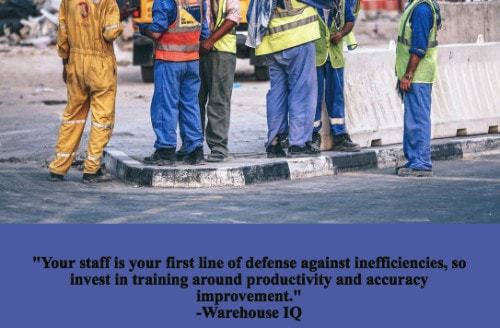
23. Don’t skimp on staff training. “Warehouse productivity is undermined as customer requirements change. Your staff is your first line of defense against inefficiencies, so invest in training around productivity and accuracy improvement. Also, introduce management-supported quality circles, because these regular meetings can identify problems and reveal solutions. These practices will result in ongoing improvement.” — Order Picking Strategies for a Warehouse, Warehouse IQ; Twitter: @WarehouseIQ
24. Ask yourself key questions before you commit to a picking method. “It is essential to implement an order picking method that is right for your business and customers. To determine which will work for you, it is important to consider the following:
- The type of operation you have
- Characteristics of product being handled
- Total number of transactions and orders
- Picks per order
- Quantity of pick
- Picks per SKU
- Total number of SKUs
- Whether you are handling piece pick, case pick, or full-pallet loads
“Sometimes a combination of picking methods is needed to handle diverse product and order characteristics.” —Order Picking in the Warehouse, AdaptaLift Group; Twitter: @AdaptaliftGroup

25. Organized commonly-picked items into “hot zones.” “Group commonly ordered items together to form a hot zone. That way your business can knows exactly where to go for, saving travel and locating time. If orders tend to be grouped by a particular category, set up zones within that category from most-picked to least-picked.” — Cassandra Marks, 5 Solutions to Improve Order Picking Productivity, Sphere WMS; Twitter: @SphereWMS
26. Shore up your replenishment practices. “Check and replenish your inventory as needed. There’s nothing more frustrating than for a picker to find an empty slot where the customer’s order is to be picked from. There are computer applications available that can help you check the status of your inventory. This helps you to order more stock before your inventory becomes depleted.” — How to Improve Order Picking in Your Warehouse, FlexQube; Twitter: @FlexQube
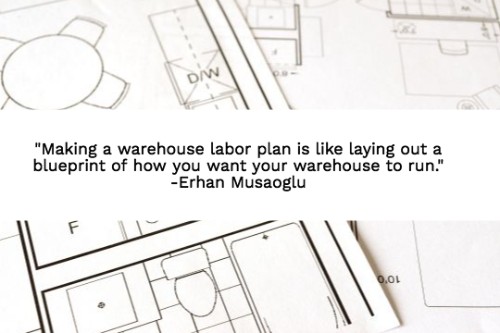
27. Create a shrewd warehouse labor plan. “Making a warehouse labor plan is like laying out a blueprint of how you want your warehouse to run. This helps you understand how everything in the picking and packing process can affect speed and efficiency, from the setup time to the time it takes to pick a batch.” — Erhan Musaoglu, Warehouse Picking and Packing Processes: How Much Labor Do You Need?, Explore WMS; Twitter: @ExploreWMS
28. Embrace a system that prioritizes important orders. “Some orders need to be fulfilled more quickly than others. Perhaps the customer purchased next-day delivery, so the order must be picked and packed immediately, or maybe the shopper had a customer service nightmare with the merchant with their last purchases, so retailers may want to make up for it by expediting the delivery time. Maybe yet, the customer spent a lot of money or is a regular patron and merchants want him or her to get their orders promptly to show their appreciation. Whatever the reason, some orders should be prioritized over others, and this should influence picking strategies.” — 5 Factors that Influence Order Picking in the Warehouse, SalesWarp; Twitter: @SalesWarp

29. Use smart recruitment strategies to hire top-notch warehouse workers. “Recruiting for distribution and fulfillment centers can be uniquely challenging these days. More and more businesses are attempting to draw talent from a smaller pool of applicants than ever before. If you want to know how to attract warehouse workers to your company, there are some simple strategies you can follow.
“You can stay ahead of the curve by enacting a proactive recruitment strategy that incorporates a robust referral program and provides tailored benefits that will appeal to workers in your community.” — Matthew DeMarco, Recruit Warehouse Workers Like a Pro, Staff Management|SMX; Twitter: @staffmanagement
30. Instead of settling on fixed locations, opt for a more flexible solution. “Introduce a WMS that allows for dynamic locations. This will mean that you can put multiple stock keeping units (SKUs) in one location, as well as putting single SKUs in multiple locations. By doing this, you will make much better use of the space in your warehouse, save money and postpone the need to move to a larger site.” — Jonathan Bellwood, 10 Common Problems with Order Picking…and How to Solve Them, Peoplevox; Twitter: @Peoplevox

31. Keep your inventory bottom-heavy. “When picking, make sure heavy items stay at the bottom of the carton or carriage and are picked first, and the lighter, crushable items are kept on top and picked last.” — Order Picking Basics, Modern Materials Handling; Twitter: @modernmhmag
32. Say ‘goodbye’ to paper. “If you’re looking to further improve the efficiency of your warehouse pickers, consider doing away with paper picking slips, if you’re still using these. Going digital will let you incorporate other advantages like intelligent picking routes that’ll provide your pickers with the shortest, most efficient route to take as they go about their work.” — Pick, Pack, and Ship–Making Order Fulfillment Easy, TradeGecko; Twitter: @tradegecko
Warehouse management system tips

34. Pair barcode technology with your WMS. “Whether you run a large or small warehouse operation, the amount of time spent picking orders can add up. Avoid the constant back-and-forth process as well as costly manual errors with the help of technology. The use of barcodes can maximize organization, improve warehouse inventory management and accuracy and help employees choose the right products at the right time.” — Moving Inventory the Right Way: 5 Key Warehouse Management System Tips, Hughes Enterprises; Twitter: @HughesNewJersey

35. Select a WMS that can scale with your company. “How much do you plan on growing your business in the coming years? A good WMS should have the capabilities of growing alongside your company. Sure, any WMS can probably account for your current inventory, but what if your inventory doubles? Triples? There is no point in investing both time and money into a WMS that your company will quickly outgrow. You want to invest in one that is not only capable of growing with your company, but capable of helping your company grow.” — Aaron Mikel, How to Choose the Right Warehouse Management System, SkuVault; Twitter: @skuvault
36. Your WMS should optimize your labor allocation. “With variables such as the size of your facility and special material handling requirements, you need to approach efficiency differently at each stage of the workflow. Your WMS should be able to assist — if not outright allocate — these on-the-floor tasks in the most logical, efficient way possible. Even if your system only delivers metrics, you’ll still be getting crucial decision-making data that you can shape into the best approach possible.” — Steve Hitchings, 10 Benefits of Choosing the Correct WMS for You, Kenco; Twitter: @KencoGroup
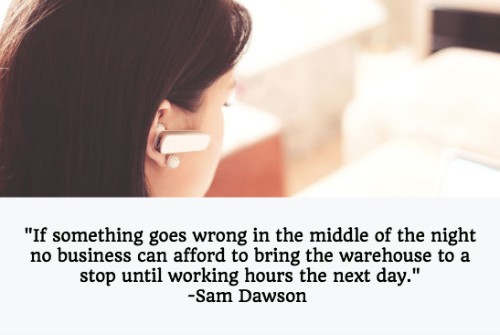
37. Choose a WMS with a comprehensive support system. “Support for your WMS is not only required for the implementation of the system, your WMS provider must offer a well-staffed 24 X 7 help desk throughout the life of the system. If something goes wrong in the middle of the night no business can afford to bring the warehouse to a stop until working hours the next day. WMS providers that own their software and deploy it around the world are much more reliable options than companies deploying 3rd party software under license.” — Sam Dawson,7 Questions to Ask When Choosing a Warehouse Management System, Microlistics; Twitter: @microlisticswms
38. Use the WMS to streamline existing software systems. “The WMS can integrate seamlessly with your enterprise resource planning (ERP) system, as well as automate transactions with supply chain partners using electronic data interchange (EDI) — a capability mandated by more and more retailers and manufacturers. Integration among WMS, ERP and EDI will reduce or eliminate manual data entry errors and chargebacks, greatly accelerate transaction processing, streamline onboarding of new trading partners and increase productivity without increasing staff.” — 8 Ways WMS Can Optimize Omnichannel Fulfillment for Distributors, Icepts Technology Group, Inc.; Twitter: @icepts

39. See real results when a WMS is introduced to support new automation. “As we consult with omnichannel fulfillment companies, they sometimes want to know how automation will benefit them, but they don’t have solid warehouse processes and systems as a foundation. A Warehouse Management System (WMS) and automation are not an “either/or” decision. There are dozens of benefits to WMS and automation when considered separately but to get the highest benefits, you need to consider the synergy of the two together.” — Brian Barry, Gaining WMS, Automation Synergies for Your E-commerce Operations, Multichannel Merchant; Twitter: @mcmerchant
Warehouse automation tips
40. Collaborative robotics work magic when programmed with strategy in mind. “What we refer to as autonomous mobile robots are not. They are not really autonomous that is. Autonomy suggests some level of independence by a human, or a robot, in picking which tasks to work on and how they are completed. But the ROI from mobile robots is based on the centralized intelligence that choreographs the movement of human associates and the fleet of robots that support them in in a manner that minimizes travel for the associates.” — Steve Banker, Collaborative Robots Used in E-Commerce Fulfillment, Forbes; Twitter: @Forbes

41. Investing in collaborative technology for fulfillment means keeping up with the competition. “In 2016, [collaborative robots] accounted for less than five percent of global industrial robot sales; but by 2020 industry analysts believe the [collaborative robots] market could surge to $3 billion, with 150,000 units in use — a number they say could more than quadruple by 2025. If current trends continue, 2018 will be remembered as the year that [collaborative robots] really entered the mainstream.” — Advanced Manufacturing: The Cobots Are Coming, Business Facilities; Twitter: @BizFacilities
42. Use collaborative mobile robots for a directed workflow. “At 6 River Systems, we developed Chuck, a mobile warehouse robot that is designed to help today’s warehouses make the most out of the labor they already have. In the past, warehouses had to rely on machines, such as conveyors, automated storage and retrieval systems and shuttles, to eliminate walking and shorten ecommerce fulfillment times. However, those solutions are often bulky and less versatile compared to modern alternatives.
“Because of this, we created an ultra-flexible line of collaborative robots that swiftly move across your warehouse floor, speeding up the picking rate by roughly 2-3x. Using a directed workflow approach, our collaborative robots pace your associates to help them quickly move through all the steps in the picking process, and our cloud-based software intelligently groups similar orders together to boost efficiency. Plus, Chuck works with your desired picking method, whether it’s wave, batch, zone, discrete, cluster or a combination of methods.” — Fergal Glynn, What is automated warehouse picking?, 6 River Systems; Twitter: @6riversystems

43. If your operation in growing, it may be time to ditch your AS/RS. “Operations that vary widely in terms of product or materials handled from week to week or month to month may find it difficult to make AS/RS fit into their business plan. Because AS/RS works according to preset systems, processes and analysis, rapid change can be difficult to facilitate.” — Maxwell Ziegler, Pros and Cons of AS/RS for Warehouse Automation, Conveyco; Twitter: @conveyco
44. Eliminate the long walk with robotic warehouse systems. “Robotic warehouse systems drastically reduce unnecessary walking by delivering work to the operators in the active area. Collaborative robots can navigate the long distances from the induct to the active area on their own. They can plan routes efficiently, avoiding congested areas that can slow down travel time throughout the facility. Most collaborative robots use sensors to distinguish boxes from humans, moving past them swiftly and safely.” — Fergal Glynn, 3 key advantages of robotic warehouse systems, 6 River Systems; Twitter: @6riversystems

“That’s exactly what our software does. We call it smart work allocation. We apply advanced algorithms and AI in our cloud-based servers to actually reduce the number of steps that an operator takes and aisles they visit. Our software decides, in real-time, which picks are the best for your pickers while they’re in-aisle, creating more dense and productive routes than they’d get using manual carts.” — Jerome Dubois, How our software improves warehouse efficiency, 6 River Systems; Twitter: @6riversystems
46. Analyze the data delivered by your automated elements. “To add value to replenishment processes, warehouse operators need to focus on inventory management and demand planning. As Logistics Management noted, the required attention to detail is certainly made easier through the adoption of a smart WMS, but the addition of forecasting and strategizing around expected demand is what makes replenishment fully optimized.”–Chris Anton, How to Optimize Warehouse Replenishment, Snapfulfil; Twitter: @Snapfulfill

47. Take advantage of real-time metrics to streamline fulfillment and predict problems. “There are various apps that can be used to track metrics, from data that includes pick up size, the time needed for delivery, where the delivery vehicle is, how long it’s been in the facility and so on. This allows customers to determine whether factors in the warehouse climate need to be changed, as well as figure out if there are any issues with vehicles, automated or otherwise. This also contributes to more predictability in the warehouse — it becomes much easier to tell what is being moved, when and where.” — Leslie Sullivan, Top 10 Features of an Autonomous Warehouse, Evans Distributions Systems; Twitter: @evansdist
48. Use your on-demand data to display big-picture metrics and goals. “…warehouse operations are usually goaled by metrics based on unit volumes, such as number of picks, shipments and receipts — without regard to the value of goods handled. Adding in metrics based on values such as the revenue, margin, and profitability derived from goods will incent a warehouse to be more revenue and profitability oriented. Supplementing the typical goals that are focused only on being cheap, productive, fast and accurate, with the values-oriented objectives would better align warehouse goals with other corporate objectives.” — Larry Lipide, Do Your Warehouse Goals Support Business Strategy?, Supply Chain 24/7; Twitter: @SupplyChain247

49. Don’t let clunky goods-to-person infrastructure slow down fulfillment. “With goods-to-person automation, you get rid of all the long walks, so your throughput shoots up to 300 UPH. It sounds great on paper. But you don’t completely eliminate walking, because operators are still taking steps in their stations to grab and pack products. You might have a stellar UPH, but you’ve also got a tremendous amount of expensive and inflexible infrastructure to maintain. What if your product mix or your order profile changes?” — Jerome Dubois, Work Smarter: How Collaborative Robotics Deliver Better Value than Goods-to-Person, 6 River Systems; Twitter: @6riversystems
50. Make real-time data accessible to your warehouse staff. “What employees really gain through the use of mobile computers, smartphones and wearables — which can include everything from digital eyewear to ring scanners — is access to real-time information. Data is increasingly valuable in the warehouse and DC, especially as customer expectations escalate to include very short shipping turnaround times due to increasing competition from large e-tailers like Amazon. In warehouse and DC environments, conditions are ever-changing, so being able to consult with a WMS, on a moment’s notice, to determine if an order got out the door on time is beneficial.” — Carrie Mantey, Hardware that Helps Facilitate Hard Work, Supply & Demand Chain Executive; Twitter: @SDCExec
